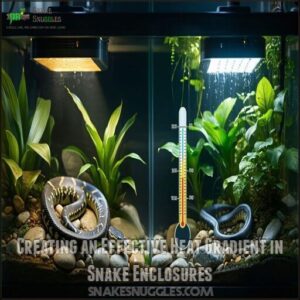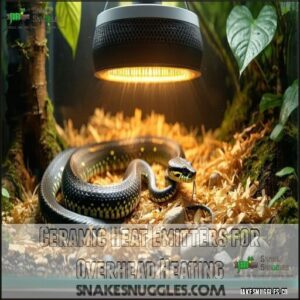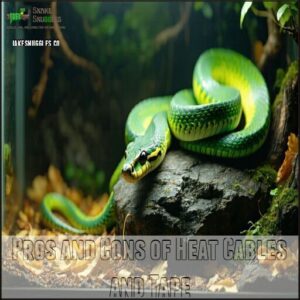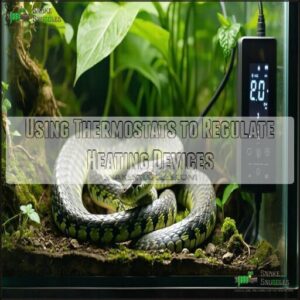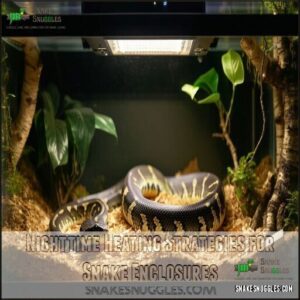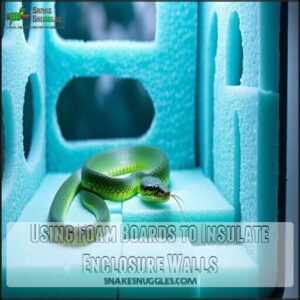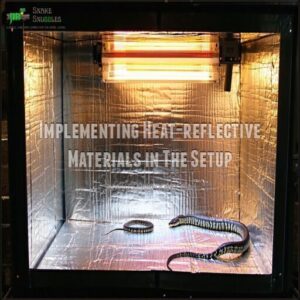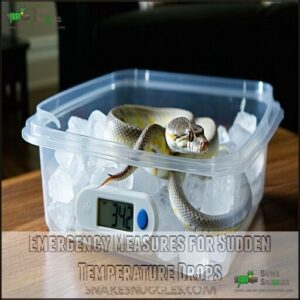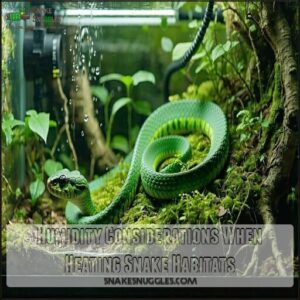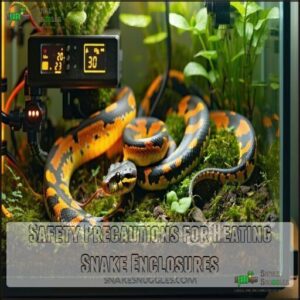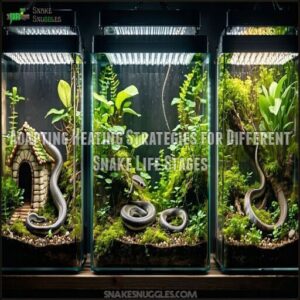This site is supported by our readers. We may earn a commission, at no cost to you, if you purchase through links.
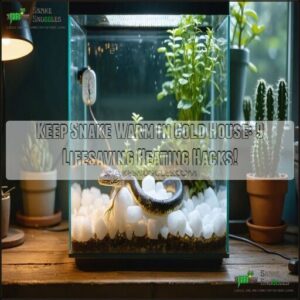
Use a heat mat or ceramic heat emitter to create a warm zone that mimics their natural habitat.
You’ll want to maintain a temperature gradient between 75-95°F, depending on your snake’s species.
Don’t rely on room temperature alone—snakes are cold-blooded and can’t regulate their body heat like mammals.
Invest in a reliable thermostat to prevent overheating, and place a thermometer in the enclosure to monitor temperatures.
Insulate the habitat with foam boards and avoid drafty areas.
Your snake’s survival depends on consistent, carefully managed warmth.
Table Of Contents
- Key Takeaways
- Essential Temperature Requirements for Snake Health
- Creating an Effective Heat Gradient in Snake Enclosures
- Selecting Appropriate Heating Equipment for Snake Habitats
- Nighttime Heating Strategies for Snake Enclosures
- Insulating Snake Enclosures in Cold Environments
- Emergency Measures for Sudden Temperature Drops
- Humidity Considerations When Heating Snake Habitats
- Safety Precautions for Heating Snake Enclosures
- Adapting Heating Strategies for Different Snake Life Stages
- Frequently Asked Questions (FAQs)
- How to keep a snake warm in a cold room?
- What temperature is too cold for a snake?
- How to keep a snake warm without a heat lamp?
- How long can a snake go without a heating pad?
- How do you keep a snake warm in a cold house?
- How do you keep a snake warm in a vivarium?
- How do you keep a scaly snake warm?
- Can a snake live in a cold house?
- What temperature should a snake’s enclosure be?
- What should I do if my snake gets cold?
- Conclusion
Key Takeaways
- You’ll need to create a precise temperature gradient in your snake’s habitat, ranging from 75-95°F, depending on the species. Don’t rely on room temperature alone—snakes can’t regulate their body heat like mammals and depend entirely on their environment for warmth.
- Invest in reliable heating equipment like heat mats, ceramic heat emitters, and radiant heat panels, always using a thermostat to prevent dangerous temperature fluctuations. Strategic placement of these devices will help you mimic your snake’s natural thermal habitat.
- Monitor your snake’s behavior closely for signs of temperature stress, such as prolonged lethargy, reduced movement, or unusual hiding patterns. These signals can help you quickly adjust the habitat to prevent potential health complications.
- Insulate your snake’s enclosure using foam boards, reflective materials, and draft stoppers to maintain a consistent temperature. Creating a draft-free environment with heat-retention techniques is crucial for your snake’s survival in a cold house.
Essential Temperature Requirements for Snake Health
If you’ve got a slithery friend shivering in your chilly home, you’ll want to understand exactly how temperature affects your snake’s survival.
Your snake’s health depends critically on maintaining the right heat gradient, as these cold-blooded creatures can’t generate their own warmth and rely completely on their environment to regulate body temperature.
Temperature isn’t just comfort for snakes—it’s their survival lifeline, determining every aspect of their biological functioning.
Optimal Temperature Ranges for Different Snake Species
Every snake owner needs to know their slithery friend’s unique temperature language.
Understanding species-specific temperature needs is vital for snake health and happiness.
When setting up your snake’s habitat, consider these ideal ranges:
- Ball pythons: Tropical lovers craving 75-85°F
- Corn snakes: Temperate dwellers enjoying 70-85°F
- Boa constrictors: Warmth seekers thriving at 78-88°F
- King snakes: Adaptable friends comfortable between 70-80°F
Mimicking natural habitats isn’t just nice—it’s essential.
By creating precise temperature gradients, you’re not just keeping your snake warm; you’re speaking their biological language of survival and comfort.
Importance of Maintaining a Proper Heat Gradient
Your snake’s thermal resort isn’t just a habitat—it’s a lifeline.
By designing a precise heat gradient, you’re activating thermoregulation benefits that mirror natural environments.
Strategic placement of heat sources creates zones where your snake can seamlessly move between warm and cool areas, optimizing digestive efficiency and ensuring robust health through gradient stability.
Signs of Temperature-related Stress in Snakes
Thermostats aren’t the only ones tracking your snake’s comfort level – your scaly friend communicates temperature stress through subtle signals.
Watch for telltale signs like prolonged lethargy, sudden appetite loss, or unusual burrowing behavior that hint at cold stress. These symptoms reveal your snake’s struggle with temperature regulation.
- Regurgitation can signal significant thermal discomfort
- Reduced movement often indicates insufficient warmth
- Persistent hiding might suggest your snake is seeking refuge from cold
Your snake relies on you to interpret these distress signals. Understanding their body language helps prevent serious health complications and guarantees a comfortable, stable environment for your reptilian companion, ensuring your snake’s overall well-being and comfort.
Risks Associated With Prolonged Cold Exposure
Cold creeps like a silent predator, threatening your snake’s well-being.
Prolonged temperature drops can trigger devastating health consequences, including severe lethargy and appetite loss.
Your reptilian friend becomes vulnerable to life-threatening conditions like hypothermia and compromised immune responses.
Digestive and excretory problems emerge as telltale signs of distress, with burrowing behavior signaling desperate attempts to escape the chill.
Vomiting and regurgitation might indicate severe snake cold symptoms, revealing the profound impact of inadequate heating.
Vigilant monitoring and immediate intervention are your snake’s lifeline against these dangerous thermal challenges, and it is crucial for preventing devastating health consequences.
Creating an Effective Heat Gradient in Snake Enclosures
If you’ve got a cold house and a snake that’s shivering, you’ll need to master the art of creating the perfect temperature gradient.
Your snake’s survival depends on strategic heat placement and careful monitoring, so let’s explore how to transform your chilly enclosure into a warm, snake-friendly sanctuary.
Setting Up Warm and Cool Zones
Your snake’s comfort hinges on creating a smart thermal gradient.
By designing distinct warm and cool zones, you’ll give your scaly friend the power to regulate body temperature naturally.
Think of it like a reptilian comfort control panel—where they can bask or chill as needed.
Mimic their wild habitat and watch them thrive in their personalized temperature paradise.
Placement of Heat Sources for Optimal Temperature Distribution
A heat-lamp harmony in your snake’s domain guarantees uniform warmth distribution.
Strategic placement transforms your enclosure into a thermal paradise:
- Mount heat sources to create a seamless temperature gradient
- Position overhead lamps for direct, targeted basking zones
- Ensure thermostat probes accurately map thermal landscapes
- Design hide locations near warm and cool regions
Your fastidious heat source placement becomes the secret to your snake’s comfort and health.
Monitoring and Adjusting Temperatures Throughout The Day
Because maintaining the perfect thermal environment requires vigilance, you’ll want to master daily temperature monitoring for your slithery friend.
Here’s your reptilian temperature control playbook:
- Log temperatures three times daily
- Calibrate thermostats weekly
- Track seasonal temperature shifts
Remote monitoring devices can be your secret weapon in maintaining consistent snake temperature control, ensuring your pet stays comfortable and healthy.
Importance of Hiding Spots in Temperature Regulation
After fine-tuning your snake’s temperature zones, let’s talk thermal hides—your reptile’s personal climate control stations.
By strategically placing hide boxes in both warm and cool regions, you’re giving your snake a VIP pass to microclimates.
These cozy retreats let your scaly friend self-regulate body temperature, mimicking natural habitat behavior and dramatically reducing stress.
Think of thermal hides as your snake’s comfort lounges, where they can dial in their perfect warmth setting, allowing them to engage in natural behavior and thrive in their personal climate control stations.
Selecting Appropriate Heating Equipment for Snake Habitats
In terms of keeping your snake cozy in a chilly home, selecting the right heating equipment isn’t just a choice—it’s a survival strategy for your cold-blooded companion.
Understanding the nuanced world of heat mats, ceramic emitters, and radiant panels will transform your snake’s habitat from a potential freezer to a perfectly regulated tropical paradise.
Heat Mats and Their Benefits for Keeping Snakes Warm
Snaking through the domain of reptile care, heat mats offer a game-changing solution for keeping your slithery friend cozy.
Want to transform your snake’s habitat into a temperature paradise? Here’s why heat mats rock:
- Provide consistent belly warmth for natural thermoregulation
- Create safe, controllable heating zones
- Prevent cold-related health issues
- Work seamlessly with species-specific needs
Under-tank heaters (UTH) deliver targeted warmth, mimicking the ground temperatures snakes naturally seek. By strategically placing a heating pad with a reliable thermostat, you’ll create the perfect thermal gradient. To guarantee proper thermal balance, match pad size to the enclosure dimensions.
Different snake species have unique heating requirements, so choose a mat that matches your pet’s specific needs. Burn prevention is vital—always use a quality thermostat and monitor the temperature carefully. Your snake will thank you with vibrant health and comfortable lounging.
Ceramic Heat Emitters for Overhead Heating
Your snake’s overhead ceramic heat emitter (CHE) is a game-changing warmth solution that transforms reptile habitats with scientific precision.
These silent heat distribution champions offer unparalleled temperature control for snake enthusiasts.
- Energy-efficient design maximizes snake comfort
- Eliminates disruptive light during heating
- Extends equipment lifespan substantially
- Compatible with most snake species
Pairing your CHE with a reliable thermostat guarantees consistent warmth, preventing dangerous temperature fluctuations.
These devices are available at reptile heating product retailers.
By strategically placing these ceramic heat emitters, you’ll create a safe, cozy environment that mimics your snake’s natural thermal landscape, providing your pet with the best possible care through scientific precision.
Radiant Heat Panels for Larger Enclosures
When ceramic heat emitters lose their shine, radiant heat panels step up as the superhero of large snake enclosures. These thermal wizards distribute warmth like a pro, making cold houses no match for your slithery friend’s comfort.
Mounting panels on the ceiling or enclosure sides creates a perfect heat gradient that’ll have your reptile buddy feeling toasty. You can find radiant heat products online for various reptile needs.
Your panel’s performance depends on smart placement and thermostat control. By understanding panel efficiency and matching it to your enclosure size, you’ll create a safe, warm haven that keeps your snake happy and healthy.
Pros and Cons of Heat Cables and Tape
Because heat cables and tape can be tricky, you’ll want to master their safe installation for your snake’s comfort.
Master heat cables with care—your snake’s comfort depends on precise, safe thermal techniques.
Here are three key considerations:
- Position cables carefully to create an even heat gradient
- Use reflective aluminum tape to maximize heat reflection
- Monitor installation to prevent potential hot spots
Consider using specialized reptile products for maximum safety. Choose wisely to guarantee your reptile’s warmth without breaking the bank, ensuring a comfortable environment with even heat.
Using Thermostats to Regulate Heating Devices
In the realm of reptile care, a thermostat is your secret weapon for maintaining the perfect habitat.
Precision is key when regulating your snake’s warmth. Check out this quick guide to mastering temperature control:
| Feature | Benefit |
|---|---|
| Probe Placement | Accurate Readings |
| Calibration | Consistent Heat |
| Safety Checks | Reliable Performance |
Monitor settings closely to prevent dangerous temperature fluctuations and keep your scaly friend comfortable.
Nighttime Heating Strategies for Snake Enclosures
When the sun sets and temperatures drop, your snake’s nighttime comfort becomes a critical concern that can make or break its health.
Understanding and implementing strategic heating methods will help you create a safe, warm haven that mimics your snake’s natural environment and supports its physiological needs.
Maintaining Proper Temperatures During Dark Hours
Nighttime’s silent challenge demands strategic warmth for your cold-blooded companion. Keeping your snake’s habitat comfortable after sunset isn’t just care—it’s survival.
Here’s how to maintain that critical temperature gradient:
- Deploy heat mats with thermostats for consistent, belly-hugging warmth
- Leverage ceramic heat emitters (CHEs) to radiate gentle, lightless heat
- Wrap heat cables strategically around the enclosure to eliminate cold zones
Precise overnight temperature management mimics natural environments, preventing stress and potential health risks. Your snake’s comfort hinges on understanding these nuanced nighttime heating strategies, transforming a potentially dangerous scenario into a cozy, safe retreat.
Red or Infrared Bulbs for Nocturnal Heat Provision
When the sun sets and temperatures drop, your slithery friend needs gentle warmth without disrupting sleep.
Infrared bulbs offer a snake-friendly solution for nocturnal heating:
- Invisible heat spectrum prevents light disturbance
- Mimics natural thermal environments
- Provides consistent, safe warmth without eye strain
These specialized bulbs keep your reptile cozy while preserving its natural day-night rhythms, ensuring comfort through the darkest, coldest nights with gentle warmth and maintaining a natural environment.
Using Heat Mats for Consistent Nighttime Warmth
Your snake’s lifeline during chilly nights? A carefully placed under tank heater.
Cover roughly one-third of the enclosure’s bottom with a heating pad, always using a reliable thermostat to prevent overheating.
Position the mat strategically, ensuring it doesn’t contact the tank directly, and regularly inspect for any potential malfunctions to keep your slithery friend safe and cozy.
Using a reliable thermostat is crucial to prevent overheating and ensure the well-being of your pet.
Adjusting Temperatures to Mimic Natural Day-night Cycles
Because temperature plays a vital role in reptile health, you’ll want to mimic nature’s rhythms in your snake’s habitat.
Natural day-night cycles involve gradual temperature shifts that support well-being:
- Drop temperatures 5-10°F after dark
- Simulate wild habitat conditions
- Promote healthy thermal cycling
- Support snake’s circadian rhythm
This gentle heat variation guarantees your scaly friend stays comfortable and stress-free during nocturnal temperature drops, which is essential for their overall well-being.
Insulating Snake Enclosures in Cold Environments
If you’re a snake owner living in a chilly home, you’ll need to master the art of enclosure insulation to keep your scaly friend healthy and comfortable.
Creating a warm, draft-free environment involves strategic heat retention techniques that protect your snake from the cold’s potentially dangerous effects.
Choosing Appropriate Substrate for Heat Retention
Your substrate isn’t just bedding—it’s your snake’s thermal superhero.
Coconut fiber and cypress mulch aren’t random choices; they’re scientifically superior for heat retention and moisture control.
By mimicking natural habitats, these substrates create a cozy microclimate that helps regulate body temperature, satisfy burrowing instincts, and keep your slithery friend comfortable in chilly environments, making them a vital part of your snake’s thermal regulation.
Using Foam Boards to Insulate Enclosure Walls
Protecting your slithery friend from chilly walls starts with smart insulation. Foam boards work like thermal magic, transforming your snake’s enclosure into a cozy haven. Choose 1/2-inch thick boards cut precisely to your vivarium’s dimensions, leaving strategic ventilation gaps.
Why foam boards rock for reptile comfort:
- Boost thermal mass without breaking the bank
- Provide consistent warmth across enclosure walls
- Easy to install with minimal DIY skills required
Your DIY insulation project doesn’t need to be complicated. Custom-fitting foam boards can dramatically reduce heat loss, keeping your reptilian companion warm and stress-free. Professional-grade boards offer long-term durability, making them a cost-effective solution for maintaining ideal habitat temperatures. Just remember: proper installation means happy, healthy snakes.
Implementing Heat-reflective Materials in The Setup
You’ll want to turn your snake’s enclosure into a heat-trapping fortress! Strategically placing aluminum foil or polystyrene tiles can dramatically boost warmth retention.
These reflective materials create a thermal shield, bouncing heat back into the enclosure and helping maintain a cozy environment.
Consider PVC panels for excellent insulation. Your scaly friend will thank you for this savvy insulation hack that keeps cold at bay, making it a great way to create a warm and welcoming space for your pet, which is a key part of being a responsible snake owner and providing a cozy environment.
Creating a Draft-free Environment for Snakes
After strategically placing heat-reflective materials, you’ll want to block those sneaky drafts that can chill your scaly friend.
Your snake’s comfort depends on a well-sealed home:
- Seal microscopic gaps with silicone caulk
- Block airflow with draft stoppers
- Insulate walls with foam boards
- Reduce ventilation without compromising air quality
Create warm hideaways that transform your cold house into a cozy snake sanctuary, ensuring your reptilian companion stays stress-free and toasty.
Emergency Measures for Sudden Temperature Drops
When sudden temperature drops threaten your snake’s survival, you’ll need quick and effective emergency heating strategies.
Your snake’s life depends on maintaining a safe thermal environment, so it’s imperative to act fast and implement temporary warming techniques that can prevent potentially fatal cold stress.
Temporary Heating Solutions During Power Outages
When the power grid fails, your snake’s survival depends on quick thinking.
Grab chemical hand warmers, wrapping them in a thin cloth to prevent direct contact. Nestle a towel-wrapped hot water bottle near your snake’s enclosure, creating a warm sanctuary.
Consider moving the habitat to a heated room or car—your temporary snake shelter during the blackout.
Using Hand Warmers or Hot Water Bottles Safely
Three key strategies can help you safely use hand warmers and hot water bottles during snake emergencies. Carefully wrap these heat sources in cloth to prevent direct contact and potential burns.
Remember that snakes can enter a state of natural torpor to conserve energy.
To ensure safe and effective use, follow these guidelines:
- Maintain distance between heat source and snake
- Check warming devices for leaks
- Use battery-powered options with adjustable temps
- Insulate heat sources with soft materials
- Monitor snake’s response to emergency heating to prevent any adverse reactions.
Creating a Warm Retreat Using Blankets or Towels
Snake owners, your secret weapon against the cold is a cozy blanket fortress! Select soft, thick materials like fleece or wool to create a warm retreat.
Fold towels or blankets into a snug shelter, ensuring your snake has room to curl up.
Place the makeshift heat haven in a draft-free corner, providing temporary emergency warmth during unexpected temperature drops, and utilize it as your secret weapon.
Monitoring Snake Behavior During Emergency Situations
In the midst of an emergency, stay on high alert for your snake’s cold stress signifiers.
Watch closely for telltale stress indicators that reveal your reptile’s health during temperature fluctuations.
- Sudden, sluggish movements scream "I’m cold!"
- Unexpected retreat to dark hiding spots
- Unusual stillness signals potential distress
- Irregular breathing patterns raise red flags
- Digestive changes hint at temperature trauma
Immediate action prevents lasting damage.
Humidity Considerations When Heating Snake Habitats
When heating your snake’s habitat, you’ll need to pay close attention to both temperature and humidity levels to guarantee your scaly friend stays healthy and comfortable.
Your heating methods can substantially impact the moisture balance in the enclosure, so it’s vital to choose heat sources and techniques that maintain ideal humidity while keeping your snake warm, which is crucial for maintaining a healthy environment.
Balancing Heat and Humidity Levels
Within your snake’s habitat, balancing heat and humidity is like conducting a delicate symphony.
Monitor your hygrometer closely, aiming for a 75-85°F range with precise air moisture control.
Use targeted misting frequency and strategic substrate choice to create a microclimate that mimics your snake’s natural environment, ensuring ideal ventilation and species-specific comfort.
Choosing Heat Sources That Don’t Dry Out The Air
When hunting for humidity-friendly heat sources, you’ll want to zero in on snake-safe options that maintain air moisture.
Check out these game-changing heat solutions:
- Ceramic heat emitters with moisture-preserving design
- Under-tank heating mats with controlled warmth
- Radiant heat panels minimizing air dryness
- Thermal gear engineered for reptile comfort
- Humidistats tracking precise environmental conditions to ensure reptile comfort
Implementing Misting Systems With Heating Equipment
When drying heat threatens your snake’s comfort, automated misting systems become your best defense.
Position nozzles strategically away from direct heat sources, using precision timers and thermal sensors to maintain ideal humidity balance.
Integrate fog systems with heat pumps, ensuring water quality prevents mold growth while delivering consistent moisture.
Your reptile heating setup can now provide a perfectly balanced environment that keeps your scaly friend happy and healthy, with automated misting systems.
Monitoring and Adjusting Humidity in Heated Enclosures
While managing your snake’s habitat is like curating a mini rainforest, tracking humidity is essential for their health.
Use a reliable hygrometer to monitor air moisture control precisely.
- Position water bowls strategically near heat sources
- Adjust misting frequency based on temperature and substrate moisture
Balance ventilation carefully to prevent dryness without compromising your snake’s comfort.
Safety Precautions for Heating Snake Enclosures
When keeping your snake warm, you’ll need to prioritize safety to prevent thermal injuries and electrical hazards.
Understanding the nuanced requirements of proper heating equipment installation can mean the difference between a comfortable reptile and a potentially dangerous situation for your scaly companion.
Preventing Burns and Thermal Injuries to Snakes
Every snake owner knows thermal burns can turn a cozy habitat into a danger zone.
Protect your slithery friend with these critical safety strategies:
- Use robust protective guards on all heat lamps
- Position heating pads strategically outside the enclosure
- Install digital thermostats to prevent dangerous temperature fluctuations
Careful heat source placement and consistent monitoring are your best defense against potential thermal injuries, ensuring your snake stays warm without risking painful burns.
Proper Installation and Maintenance of Heating Devices
When installing snake heating devices, precision matters. A reliable thermostat is your first line of defense for accurate temperature calibration.
Keep wiring neat and inspect electrical components regularly to prevent potential hazards. Your ceramic heat emitter or heat mat needs routine checks to extend equipment lifespan and guarantee safe reptile heating.
Dust and wear can compromise heating performance, so stay vigilant. Maintaining the correct temperature gradient is vital, so monitor enclosure temperatures to guarantee your snake’s well-being.
Using Protective Guards for Heat Lamps and Emitters
After setting up your snake’s heating system, protect your scaly friend from potential burns with smart heat lamp guards. These safety devices are your snake’s first line of defense against thermal injuries.
- Prevent direct contact with hot surfaces
- Shield delicate snake skin from burns
- Accommodate various heat lamp and ceramic emitter sizes
- Guarantee long-term reptile health and comfort
Choose wire mesh or ceramic guards that fit snugly around heat sources, creating a barrier between your curious snake and scorching equipment to ensure reptile health and prevent thermal injuries.
Regular Inspection of Electrical Components and Wiring
Your electrical lifeline for snake heating hinges on vigilant wire detective work.
Check heating components religiously for frayed wires, wobbly plugs, and sneaky overheating signs.
Perform circuit tests and voltage checks to prevent potential fires and protect your scaly friend’s sanctuary.
Regular maintenance extends component lifespan and guarantees snake heating safety without compromise.
Adapting Heating Strategies for Different Snake Life Stages
As your snake slithers through different life stages, its heating needs will transform dramatically, requiring you to be a proactive and attentive reptile caretaker.
From the delicate temperature sensitivities of juvenile snakes to the nuanced requirements of breeding, shedding, and aging serpents, you’ll need to adapt your heating strategies to guarantee your scaly companion’s peak health and comfort.
You’ll need to be aware of the various life stages, including breeding, to ensure you provide the best possible care for your snake.
Special Heating Requirements for Juvenile Snakes
Your young snake’s delicate Growth Temperatures demand precision and care.
Juvenile snake heating isn’t just about warmth—it’s a lifeline for their development.
- Monitor thermal gradients religiously
- Adjust heat with surgical precision
- Create smaller, carefully controlled enclosures
- Watch for shedding and feeding cues
Sensitive Thermoregulation means maintaining temperatures 2-3°F higher than adult requirements, ensuring your reptilian companion thrives during its most vulnerable stage.
Adjusting Temperatures for Breeding and Gestation
When breeding snakes, you’ll need to carefully manage gestation temperatures. Create a stable 86-92°F basking spot that mimics natural thermal cycles.
Each species has unique incubation requirements, so research your specific snake’s needs.
Consistent heat supports healthy egg development and increases offspring viability.
Monitor temperatures closely to optimize breeding success and guarantee robust neonate care.
Heating Considerations for Shedding Periods
Every snake’s shedding process demands precise heating strategies. Your reptile’s warmth during molting is vital for smooth skin renewal.
Create a consistent heat gradient using heating mats or ceramic emitters, maintaining temperatures between 80-85°F. Add a moisture-rich hide with damp moss to support the shedding cycle.
Proper heating prevents thermal burns or cold stress. This carefully controlled environment prevents shedding difficulty and guarantees your snake’s comfort, reducing stress and promoting healthy reptile warmth throughout the delicate transformation, ensuring a successful shedding cycle.
Modifying Heat Provision for Elderly or Ill Snakes
As your snake ages or battles illness, its heating needs shift dramatically. Gentle warming becomes your primary strategy, supporting limited mobility and immune function.
Carefully monitor your pet’s response to heat, using a precise thermostat to create comfort zones.
- Provide multiple soft, warm hides near heat sources
- Adjust prey temperature to aid digestion
- Consult a reptile veterinarian for personalized heating guidance to ensure the best care for your pet, focusing on limited mobility.
Frequently Asked Questions (FAQs)
How to keep a snake warm in a cold room?
Use heat mats, ceramic heat emitters, and radiant heat panels to create a warm thermal gradient.
Monitor temperatures with thermostats, insulate the enclosure, and provide heated hiding spots to keep your slithery friend cozy during chilly days, utilizing a combination of these methods to maintain a comfortable environment with a thermal gradient.
What temperature is too cold for a snake?
Temperatures below 70°F can spell trouble for your slithery friend.
When the mercury dips, your snake’s metabolism slows, risking health issues.
Always maintain a warm environment to keep your reptilian companion healthy and thriving.
How to keep a snake warm without a heat lamp?
You’ll need alternative heat sources like heating pads, ceramic heat emitters, or heat cables.
Place these strategically in your snake’s enclosure, ensuring a proper thermal gradient and using a thermostat to prevent overheating.
How long can a snake go without a heating pad?
In just 48 hours, your cold-blooded friend can survive without heat, but it’s risky.
You’ll want to act fast, monitor closely, and provide a warm refuge before your snake’s health takes a nosedive.
How do you keep a snake warm in a cold house?
Install a reliable heat mat with a thermostat, create a thermal gradient in the enclosure, and use ceramic heat emitters or heat lamps.
Monitor temperatures closely, ensuring your snake stays warm without risking overheating or cold stress.
How do you keep a snake warm in a vivarium?
You’ll want to create a thermal gradient in your vivarium using heat lamps, ceramic heaters, and under-tank heating pads.
Position heat sources strategically to let your snake choose its perfect temperature zone for ultimate comfort and thermoregulation.
How do you keep a scaly snake warm?
You’ll keep your scaly friend toasty by creating a thermal gradient with heating devices like ceramic heat emitters and under-tank heaters.
Monitor temperatures, use thermostats, and provide warm and cool zones for ideal snake comfort.
Can a snake live in a cold house?
No, snakes can’t survive in cold houses.
They’re ectothermic and need consistent warmth.
You’ll need heating devices like ceramic heat emitters, heat mats with thermostats, and strategic enclosure placement to maintain their critical temperature requirements.
What temperature should a snake’s enclosure be?
Your snake’s enclosure needs a precise thermal blueprint: maintain a 75-85°F gradient with a warm basking spot at 90-95°F.
Provide heating elements like heat mats or ceramic emitters to help your cold-blooded friend thrive comfortably.
What should I do if my snake gets cold?
When your cold-blooded companion shivers like a leaf in winter, act fast.
Gradually warm them using a heat lamp, heating pad, or warm towel.
Monitor closely, and consult a vet if symptoms persist or worsen.
Conclusion
Ultimately, keeping a snake warm in a cold house isn’t rocket science—it’s about understanding their unique needs.
Like a desert traveler seeking shade, your snake craves precise temperature management. By implementing strategic heating techniques, monitoring gradients, and investing in quality equipment, you’ll create a safe, comfortable environment.
Remember: consistent warmth isn’t just comfort, it’s survival. Your attentive care transforms a potentially dangerous cold situation into a thriving habitat for your scaly companion, providing them with the comfort they need.
- https://jeb.biologists.org/content/213/2/242.short
- https://www.vetexotic.theclinics.com/article/S1094-9194(15)00002-X/abstract
- https://esajournals.onlinelibrary.wiley.com/doi/abs/10.2307/1941360
- https://ball-pythons.net/forums/showthread.php?265378-How-do-I-keep-my-snake-warm-during-a-power-outage
- https://www.bangordailynews.com/2021/01/01/homestead/heres-how-to-keep-your-reptiles-comfortable-if-the-power-goes-out/


